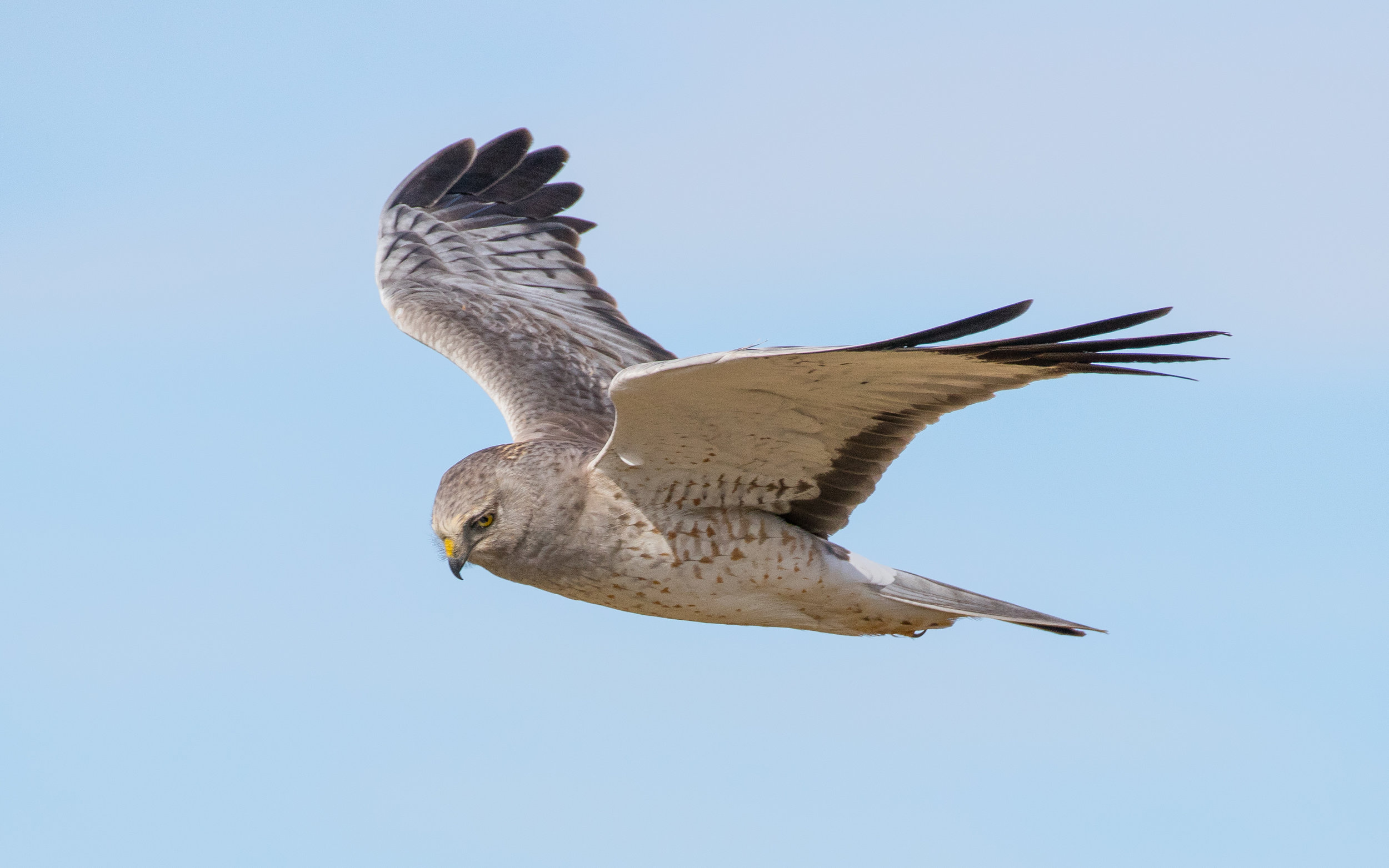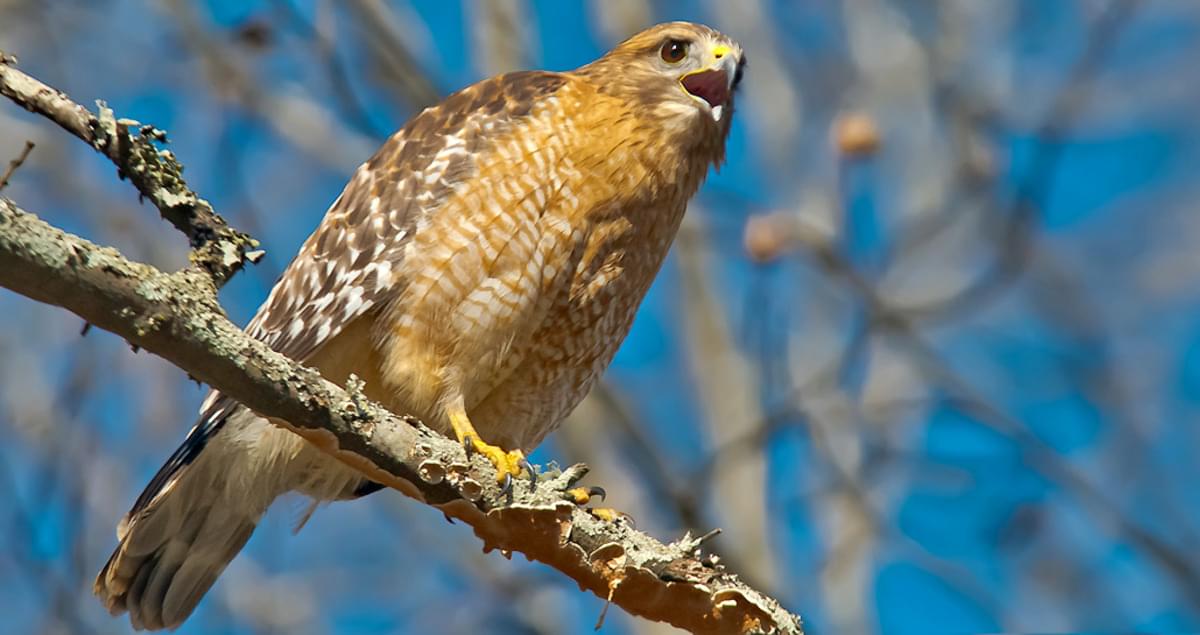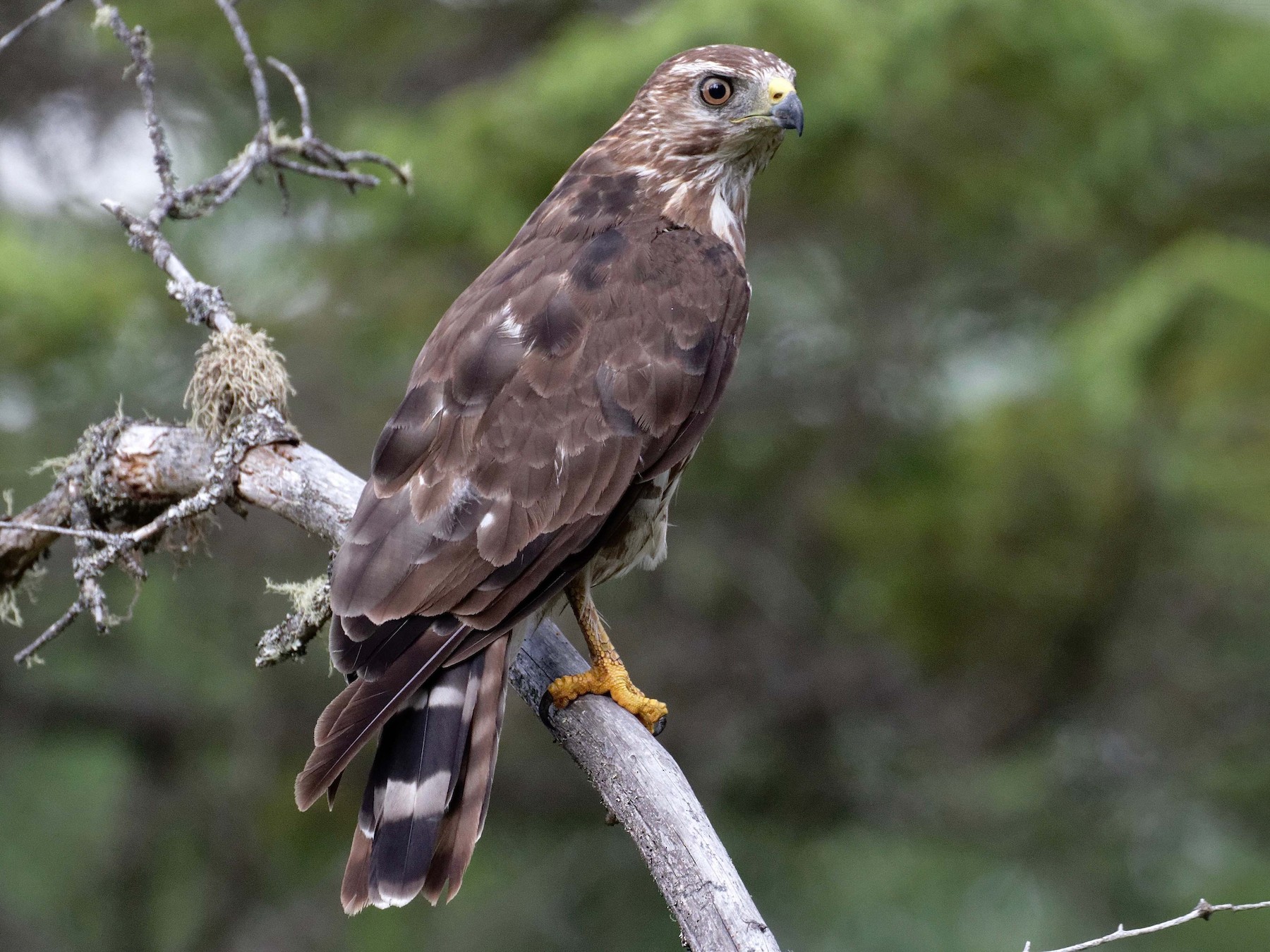Hawks are medium-sized to large birds of prey that are widely distributed throughout the United States and the rest of North America. In Virginia, you can find a variety of hawks belonging to two main categories: accipiters and buteos.
These majestic birds captivate birdwatchers and nature enthusiasts with their aerial prowess and keen hunting skills. Here, we will provide an introduction to the seven types of hawks you might encounter in Virginia, along with some key characteristics and pictures to help with identification.
You are reading: 8 Types Of Hawks In Virginia With Pictures

8 Types Of Hawks In Virginia With Pictures
Sharp-shinned Hawk
The Sharp-shinned Hawk is a small, long-tailed hawk with short, rounded wings. It has a small head that, in flight, does not always project beyond the “wrists” of the wings. The tail is square-tipped and may show a notch at the tip. Females are considerably larger than males, with the former approaching the size of a male Cooper’s Hawk.
Key Characteristics:
– Length: 9.4-13.4 in (24-34 cm)
– Weight: 3.1-7.7 oz (87-218 g)
– Wingspan: 16.9-22.1 in (43-56 cm)
Sharp-shinned Hawks are known for their secretive nature, often spending their summers under the canopy of dense forests and occasionally coming into the open to circle in the sky or fly across a field. They are most easily observed during migration, especially fall migration, when they are the most plentiful raptors seen at hawkwatch sites.
These hawks can be found in various habitats, including mixed or coniferous forests, open deciduous woodlands, thickets, and edges. They usually nest in groves of coniferous trees in mixed woods, sometimes in dense deciduous trees, or in pure coniferous forests with brush or clearings nearby.
Sharp-shinned Hawks are skilled hunters, mainly capturing small birds in flight. They often stalk feeders in search of prey and use their long toes and talons to impale and hold moving prey, even reaching into wire-mesh bird traps to grab prey with their toes.
After capturing their prey, they carry it to a stump or low branch to pluck it before eating, as swallowing feathers is not normal for them.
During migration, Sharp-shinned Hawks migrate south out of Canada and are observed at hawkwatches in large numbers, often following similar landscape features and concentrating in certain areas.
The oldest recorded Sharp-shinned Hawk was a male, at least 12 years and 2 months old when recaptured and rereleased during banding operations in Minnesota in 2009.
Cooper’s Hawk
Read more : Can Budgies Eat Kale
Cooper’s Hawk is a medium-sized hawk native to the North American continent, found from southern Canada to Mexico. Here are some key characteristics and facts about Cooper’s Hawks:
Size and Appearance:
– Length: 14.6-17.7 inches (37-45 cm) for males and females.
– Weight: 7.8-24.0 ounces (220-680 g) for males and females.
– Wingspan: 24.4-35.4 inches (62-90 cm) for males and 29.5-35.4 inches (75-90 cm) for females.
– They have a classic accipiter shape with broad, rounded wings and a very long tail.
– The head often appears large, the shoulders broad, and the tail rounded.
– Adults have a gray/blue back, white underside horizontally streaked with rufous bars, and a blue-gray top and pale underneath tail barred with three black bands.
Habitat and Behavior:
– They are common woodland hawks that can be found in mature forests, open woodlands, wood edges, river groves, and increasingly in suburbs and cities with tall trees for nest sites.
– Cooper’s Hawks are mainly arboreal, but they may come to the ground to walk.
– They are skilled fliers, capable of tearing through cluttered tree canopies in high-speed pursuit of prey.
– Their flight style is a few stiff wingbeats followed by short glides, but in pursuit of prey, their flight becomes powerful, quick, and very agile, allowing them to thread their way through tree branches at top speed.
Diet:
– Cooper’s Hawks mainly eat birds, with small birds being safer around them than medium-sized birds.
– Common prey includes European Starlings, Mourning Doves, Rock Pigeons, American Robins, several kinds of jays, Northern Flicker, quail, pheasants, grouse, and chickens.
– They also eat chipmunks, hares, mice, squirrels, and bats, with mammals being more common in their diets in the West.
Nesting:
– They build nests in various tree species, often on flat ground rather than hillsides, and in dense woods.
– Nests are typically 25-50 feet high, often about two-thirds of the way up the tree in a crotch or on a horizontal branch.
– The nest is a bulky structure of sticks, lined with softer material such as strips of bark.
– Males perform a bowing display to females after pairing and before beginning to build the nest.
Conservation:
– Cooper’s Hawk populations have increased from 1966 to 2019, according to the North American Breeding Bird Survey.
– Partners in Flight estimates a breeding population of 1,000,000, and rates them 7 out of 20 on the Continental Concern.
Northern Goshawk
The Northern Goshawk is a large and powerful hawk, known as the bigger, fiercer relative of the Sharp-shinned and Cooper’s Hawks. Here are some key characteristics and facts about the Northern Goshawk:
Size and Appearance:
– Length: 20.9-25.2 inches (53-64 cm).
– Weight: 22.3-48.1 ounces (630-1365 g) for males and 30.3-66.8 ounces (860-1895 g) for females.
– Wingspan: 40.2-46.5 inches (102-118 cm) for males and 41.7-49.2 inches (106-125 cm) for females.
– They have broad, rounded wings and long tails.
– Relatively long secondary flight feathers give the trailing edge of their wings a bulging appearance.
– Adults are overall gray, paler below, with a blackish crown and eye.
– Immature birds are similar to Eurasian Sparrowhawks and Cooper’s Hawks but larger and broader-winged, with a more prominent white eyebrow, heavier streaking below, and typically streaked undertail coverts.
Habitat and Behavior:
– Northern Goshawks are secretive birds that typically live in large tracts of forest, making them hard to find.
– They are vocal near their nests and fiercely defensive, known to attack people who come too close to a nest.
– They are solitary or found in pairs, maintaining regularly spaced home ranges that constitute their territory.
– Territories during nesting can range from 1,500 to 9,900 acres and are vigorously defended.
– They have relatively short wings and a long tail, which make them ideally adapted for brief, agile, and twisting flights in dense forest.
Diet:
– Northern Goshawks are powerful predators that hunt inside the forest or along its edge.
– They feed on a variety of prey, including birds, mammals (such as hares and grouse), and occasionally reptiles and amphibians.
Nesting:
– They build nests in trees, often in large conifers, and may reuse the same nest in subsequent years.
– The female lays 2-4 eggs, which are incubated by both parents for about 30-35 days.
– The young birds fledge at around 35-40 days old and may remain dependent on their parents for several months.
Red-shouldered Hawk

The Red-shouldered Hawk is a medium-sized hawk that is native to North America. Here are some key characteristics and facts about the Red-shouldered Hawk:
Size and Appearance:
– Length: 17 inches (43 cm).
– Weight: 1.4 pounds (640 g).
– Wingspan: 40 inches (102 cm).
– They have a stocky build, broad wings, and a long tail.
– Adults have a reddish-brown head and upper breast, with a barred tail and wings.
– Juveniles are brown above and cream-colored below, with brown streaking on their chests.
Habitat and Behavior:
– Red-shouldered Hawks are forest raptors that live in bottomland hardwood stands, flooded deciduous swamps, and upland mixed deciduous-conifer forests.
– They hunt from perches below the forest canopy or at the edge of a pond, sitting silently until they sight their prey below.
– They are vocal birds, often heard whistling plaintively from a riverine park or wet forest.
– They are territorial and defend their nesting territory year after year.
Diet:
– Red-shouldered Hawks eat mostly small mammals, lizards, snakes, and amphibians.
– They occasionally eat birds, sometimes from bird feeders.
Nesting:
– They build nests in trees, often near water, and may reuse the same nest in subsequent years.
– The female lays 2-4 eggs, which are incubated by both parents for about 30-35 days.
– The young birds fledge at around 35-40 days old and may remain dependent on their parents for several months.
Conservation:
– Red-shouldered Hawk populations have increased from 1966 to 2019, according to the North American Breeding Bird Survey.
– Partners in Flight estimates a breeding population of 1.9 million and rates them 8 out of 20 on the Continental Concern Score.
Red-tailed Hawk
The Red-tailed Hawk (Buteo jamaicensis) is a bird of prey that breeds throughout most of North America, from the interior of Alaska and northern Canada to as far south as Panama and the West Indies. It is one of the most common members within the genus of Buteo in North America or worldwide.
Here are some key characteristics and facts about the Red-tailed Hawk:
– Size and Appearance: The Red-tailed Hawk is one of the largest members of the genus Buteo, typically weighing from 690 to 1,600 g (1.5 to 3.5 lb) and measuring 45–65 cm (18–26 in) in length, with a wingspan from 110–141 cm (3 ft 7 in – 4 ft 8 in). This species displays sexual dimorphism in size, with females averaging about 25% heavier than males. They have very broad, rounded wings and a short, wide tail, which are typical Buteo proportions.
– Habitat: Red-tailed Hawks can acclimate to all the biomes within their range, occurring on the edges of non-ideal habitats such as dense forests and sandy deserts. They occupy a wide range of habitats and altitudes, including deserts, grasslands, coniferous and deciduous forests, agricultural fields, and urban areas.
– Diet: Red-tailed Hawks are carnivores and primarily eat mammals, such as rodents, rabbits, and squirrels. They hunt from perches and from the air, using their keen eyesight to spot prey from high altitudes. Once they spot a potential meal, they swoop down and grab it in their talons, then often fly back up to a perch to eat it.
– Nesting: Red-tailed Hawks often mate for life and build stick nests in trees, high above the ground. They will use the same nest year after year, and it can grow bigger over time. The female hawk lays one to five eggs, which are white with brown spots, and both parents take turns incubating the eggs. The young hawks are fed by their parents until they are about six weeks old and can leave the nest.
– Conservation Status: The Red-tailed Hawk is widespread and common, with its numbers stable or still increasing in many areas. In several regions of North America, they are adapting to nesting in cities.
Rough-legged Hawk
Read more : Discover The 8 Types Of Hawks In Maryland
The Rough-legged Hawk (Buteo lagopus), also known as the Rough-legged Buzzard in Europe, is a medium-large bird of prey found in Arctic and Subarctic regions of North America, Europe, and Russia during the breeding season.
It migrates south for the winter, and its nonbreeding range includes open fields, plains, marshes, grasslands, coastal prairies and marshes, farmland, and dunes. Here are some key characteristics and facts about the Rough-legged Hawk:
Size and Appearance:
– Length: 18.5-20.5 in (47-52 cm)
– Weight: 25.2-49.4 oz (715-1400 g)
– Wingspan: 52.0-54.3 in (132-138 cm)
– Larger than an American Crow; slightly smaller and less bulky than a Red-tailed Hawk
– Broad wings that are long and narrow compared to other Buteo hawks
– Tail longer than in many other buteos
– Wingtips are broad and often swept back slightly from the wrist, giving a hint of an M shape to the wing
– Bill is fairly small
– Legs are feathered all the way to the toes, a unique feature shared with the Ferruginous Hawk and the Golden Eagle
Habitat and Behavior:
– Breeds in the Arctic and Subarctic regions, primarily in open tundra and semi-open taiga of Alaska and Canada
– Nonbreeding range includes various open habitats in North America, Europe, and Asia
– Solitary migrant that soars, flaps, and glides while migrating
– Hovers when hunting
– Perches on fence posts, utility poles, the ground, or slender treetops, where other large raptors rarely sit
– Sometimes robs prey from other birds, including other Rough-legged Hawks, Red-tailed Hawks, Northern Harriers, American Kestrels, and Common Ravens
Diet:
– Primarily feeds on small mammals, such as mice, rats, gerbils, pikas, shrews, and squirrels
– Second most favored type of prey is small passerine birds, including snow buntings, Lapland longspurs, and American tree sparrows
Migration:
– Migrates relatively late in fall and early in spring
– Numbers appearing south of Canada are quite variable from one winter to the next
Conservation Status:
– Local populations in the Arctic go up and down, largely as a result of rodent populations there
– Overall numbers of Rough-legged Hawks are apparently healthy
Broad-winged Hawk

The Broad-winged Hawk (Buteo platypterus) is a medium-sized hawk of the genus Buteo. It is a small and compact raptor with a chunky body, large head, and distinctive features that make it easily identifiable. Here are some key characteristics of the Broad-winged Hawk:
– Size: The Broad-winged Hawk has a body size ranging from 32 to 44 cm (13 to 17 in) in length and weighs between 265 to 560 g (9.3 to 19.8 oz). Females are slightly larger than males, as is the case with most raptors.
– Wings: This hawk has relatively short and broad wings that come to a distinct point when in flight. The wings are unique in their tapered appearance.
– Tail: The tail of the Broad-winged Hawk is short and square, measuring 14.5–19.0 cm (5.7–7.5 in) in length.
– Coloration: There are two types of coloration for this species: a dark morph with fewer white areas and a light morph that is more pale overall.
– Habitat: The Broad-winged Hawk is a bird of the forest interior and can be hard to see during the nesting season. It is most easily observed during migration at hawkwatches, where it forms sometimes enormous aerial flocks, especially in southern Texas, Mexico, and along the shores of the Great Lakes.
– Call: The hawk’s call is a piercing, two-parted whistle that is often heard before the bird itself is spotted.
– Migration: Each fall, hundreds of thousands of Broad-winged Hawks leave the northern forests for South America, forming massive flocks called “kettles” during their journey. They travel from the U.S. and Canada all the way to winter in Central and South America.
Northern Harrier
The Northern Harrier (Circus hudsonius), also known as the Marsh Hawk or Ring-tailed Hawk, is a bird of prey that breeds throughout the northern parts of the northern hemisphere in Canada and the northernmost USA. Here are some key characteristics and facts about the Northern Harrier:
Size and Appearance:
– Length: 17-23 in (43-58 cm)
– Wingspan: 40-48 in (100-122 cm)
– Weight: 10-26 oz (280-730 g)
– Slender, medium-sized raptor with long, fairly broad wings and a long, rounded tail.
– Flat, owl-like face and a small, sharply hooked bill.
Habitat and Distribution:
– Found in a circumpolar distribution, breeding in the northern parts of the northern hemisphere.
– In fall through spring, they can be seen in wide-open grasslands, marshes, or fields. During migration, they may also be observed high in the sky over mountain ridges and coastlines.
Behavior and Diet:
– Northern Harriers are the most owl-like of hawks, relying on hearing as well as vision to capture prey. Their disk-shaped face looks and functions much like an owl’s, with stiff facial feathers helping to direct sound to the ears.
– They hunt mostly small mammals and small birds, but they are capable of taking bigger prey like rabbits and ducks.
– Males can have as many as five mates at once, while females incubate the eggs and brood the chicks.
Migration and Conservation:
– The Northern Harrier has a conservation status of “Least Concern” but has disappeared from many former nesting areas, especially in the southern parts of its range.
– During migration, they can form large flocks called “kettles” and are known for their low, slow, coursing flight style, V-shaped wing posture, and white rump.
FAQS
1. How many species of hawks are there in Virginia?
Virginia is home to 7 or 8 different species of hawks, depending on the source. These species include the Sharp-shinned Hawk, Cooper’s Hawk, Northern Goshawk, Red-shouldered Hawk, Red-tailed Hawk, Rough-legged Hawk, and Broad-winged Hawk.
2. Which is the most common hawk in Virginia?
The Red-tailed Hawk is considered one of the most common hawks in Virginia, if not the most common.
3. Are hawks protected in Virginia?
Yes, all hawks in Virginia are protected by state laws and the Federal Migratory Bird Treaty Act.
4. Are there Gray Hawks in Virginia?
The species known as “Gray Hawk” does not live in Virginia. However, other hawks with gray plumage, such as adult Cooper’s Hawks and Sharp-shinned Hawks, do live in the state. The adult male Northern Harrier is also mostly plumaged in gray.
5. Are there Falcons in Virginia?
Yes, six species of falcons can be found in Virginia.
6. Where can I find hawks in Virginia?
Woodlands are a good place to spot smaller hawks, such as the Sharp-shinned Hawk and Cooper’s Hawk, while open grasslands, marshes, and high ridges are suitable habitats for larger species.
Source: https://petstutorial.com
Category: Birds










